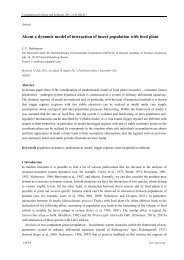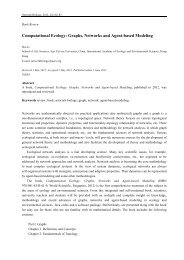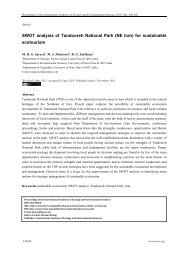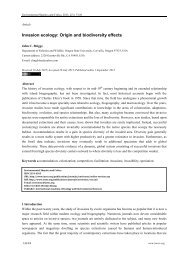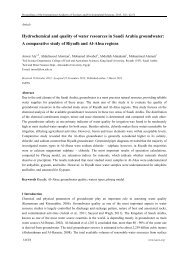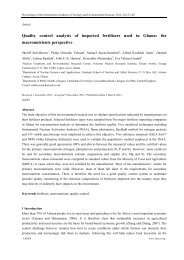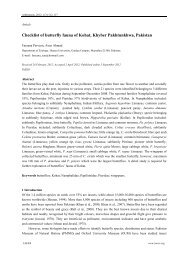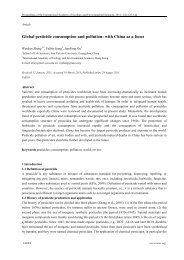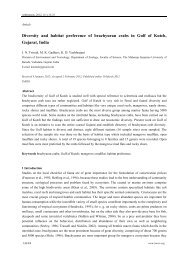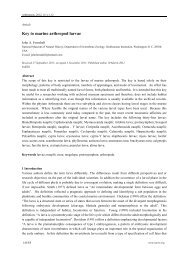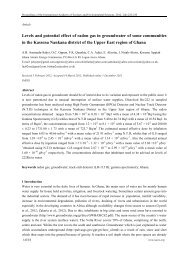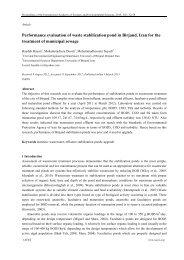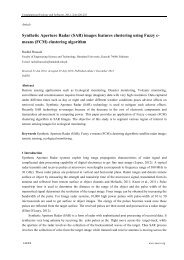Measuring competition in plant communities where it is difficult to ...
Measuring competition in plant communities where it is difficult to ...
Measuring competition in plant communities where it is difficult to ...
You also want an ePaper? Increase the reach of your titles
YUMPU automatically turns print PDFs into web optimized ePapers that Google loves.
Computational Ecology and Software, 2011, 1(3):125-137<br />
131<br />
2<br />
<strong>where</strong> <br />
P 2,<br />
i,<br />
y , r<br />
~ N (0, <br />
P 2, i<br />
) <strong>is</strong> the residual process variation from one grow<strong>in</strong>g season <strong>to</strong> the next of species<br />
i across different years and p<strong>in</strong>-po<strong>in</strong>t frames. Correspond<strong>in</strong>gly, as for (P1), different hypotheses on the effects<br />
of the environmental gradient on survival and establ<strong>is</strong>hment and the <strong>plant</strong>-<strong>plant</strong> <strong>in</strong>teractions may be tested.<br />
Note that the parameters <strong>in</strong> both process equations, (P1) and (P2), have the same notation; th<strong>is</strong> does not mean<br />
that the parameters of the two processes are identical, but only that the parameters w<strong>it</strong>h the same notation have<br />
an analogous <strong>in</strong>terpretation.<br />
The unknown states of the latent variables are connected <strong>to</strong> the observed cover and vertical dens<strong>it</strong>y by the<br />
measurement equations <strong>in</strong> such a way that the latent cover variables are assumed <strong>to</strong> be the probabil<strong>it</strong>y<br />
parameter <strong>in</strong> a b<strong>in</strong>omial d<strong>is</strong>tribution,<br />
M1: u B<strong>in</strong>( n , X )<br />
(3)<br />
i, t,<br />
y,<br />
r<br />
~<br />
i,<br />
t,<br />
y,<br />
r<br />
<strong>where</strong><br />
X<br />
i t , y,<br />
r<br />
,<br />
<strong>is</strong> the latent variable for cover of species i at time t <strong>in</strong> year y at frame r, and u <strong>is</strong> the observed<br />
number of grid po<strong>in</strong>ts <strong>where</strong> the species <strong>is</strong> h<strong>it</strong> by a p<strong>in</strong> <strong>in</strong> the same p<strong>in</strong>-po<strong>in</strong>t frame w<strong>it</strong>h n grid po<strong>in</strong>ts.<br />
The latent vertical dens<strong>it</strong>y variables are assumed <strong>to</strong> be the mean vertical dens<strong>it</strong>y <strong>in</strong> a general<strong>is</strong>ed Po<strong>is</strong>son<br />
d<strong>is</strong>tribution,<br />
M2: v gP(<br />
Y , )<br />
(4)<br />
i, t,<br />
y,<br />
r<br />
~<br />
i,<br />
t,<br />
y,<br />
r M 2,<br />
i<br />
<strong>where</strong><br />
Y<br />
i t , y , r<br />
,<br />
<strong>is</strong> the latent variable for vertical dens<strong>it</strong>y of species i at time t <strong>in</strong> year y at frame r, v <strong>is</strong> as the<br />
observed number of times the species <strong>is</strong> h<strong>it</strong> <strong>in</strong> the same p<strong>in</strong>-po<strong>in</strong>t frame, and <strong>is</strong> the degree of under<br />
d<strong>is</strong>persion, 1<br />
variance<br />
mean<br />
M 2 , i<br />
, compared <strong>to</strong> the Po<strong>is</strong>son d<strong>is</strong>tribution when measur<strong>in</strong>g the number of times a<br />
p<strong>in</strong> h<strong>it</strong>s a specific species <strong>in</strong> the p<strong>in</strong>-po<strong>in</strong>t frame.<br />
The outl<strong>in</strong>ed state-space model <strong>is</strong> only one of many possible models from a large class of possible <strong>plant</strong><strong>plant</strong><br />
<strong>in</strong>teractions models, and the f<strong>it</strong>t<strong>in</strong>g properties of the model should be <strong>in</strong>vestigated and compared <strong>to</strong> other<br />
models. A simple model compar<strong>is</strong>on approach <strong>is</strong> <strong>to</strong> f<strong>it</strong> each process equation (P1 and P2) <strong>in</strong>dependently us<strong>in</strong>g<br />
the observed values of cover and vertical dens<strong>it</strong>y and check the f<strong>it</strong>t<strong>in</strong>g properties of the models us<strong>in</strong>g residual<br />
plots.<br />
3.2 Estimation and stat<strong>is</strong>tical <strong>in</strong>ferences<br />
The state-space model may be parameterized us<strong>in</strong>g numerical Bayesian methods, <strong>where</strong> the jo<strong>in</strong>t posterior<br />
d<strong>is</strong>tribution of the model parameters and the latent variables are calculated us<strong>in</strong>g MCMC (Metropol<strong>is</strong>-Hast<strong>in</strong>gs)<br />
simulations (Carl<strong>in</strong> and Lou<strong>is</strong>, 1996; Clark, 2007).<br />
When us<strong>in</strong>g Bayesian methods, the prior d<strong>is</strong>tribution of the parameters and latent variables needs <strong>to</strong> be<br />
specified, and a simple but robust approach <strong>is</strong> <strong>to</strong> let all parameters and latent variables, except for the<br />
measurement error, ar<strong>is</strong>e from a uniform prior d<strong>is</strong>tribution w<strong>it</strong>h<strong>in</strong> the doma<strong>in</strong> of the parameter. For example,<br />
the latent cover variables, X, are assumed <strong>to</strong> ar<strong>is</strong>e from a uniform prior d<strong>is</strong>tribution between specified<br />
IAEES<br />
www.iaees.org



